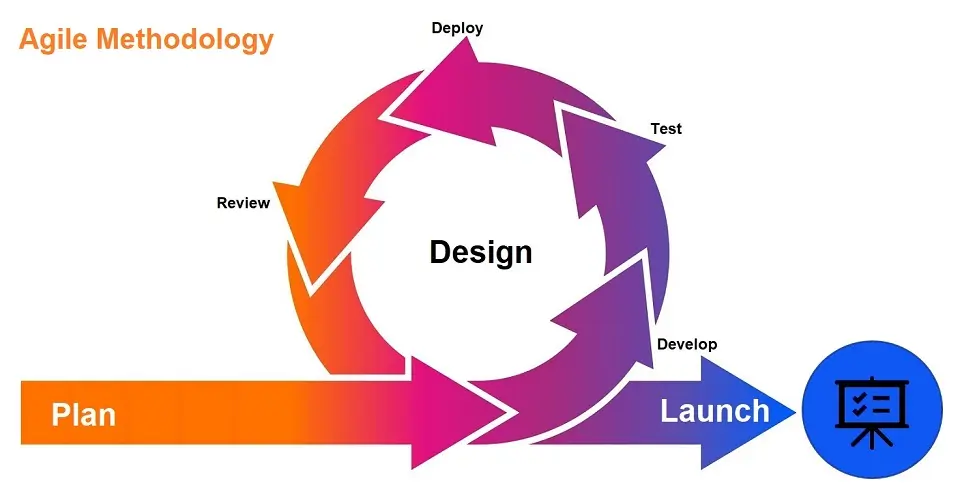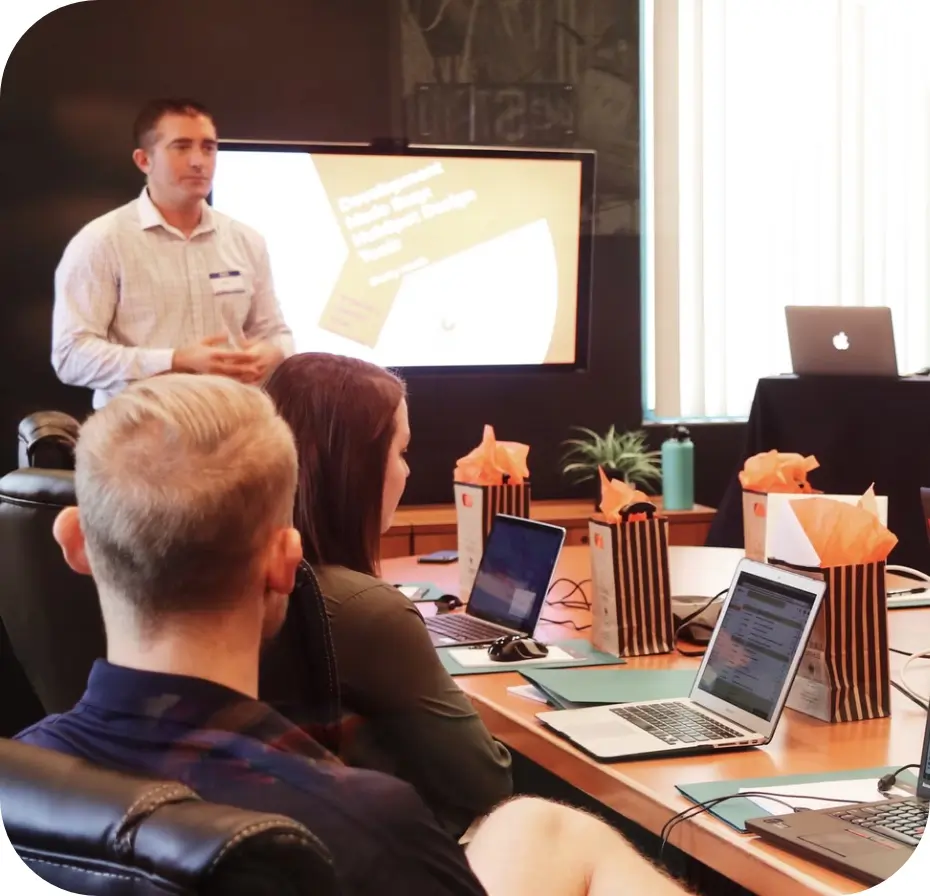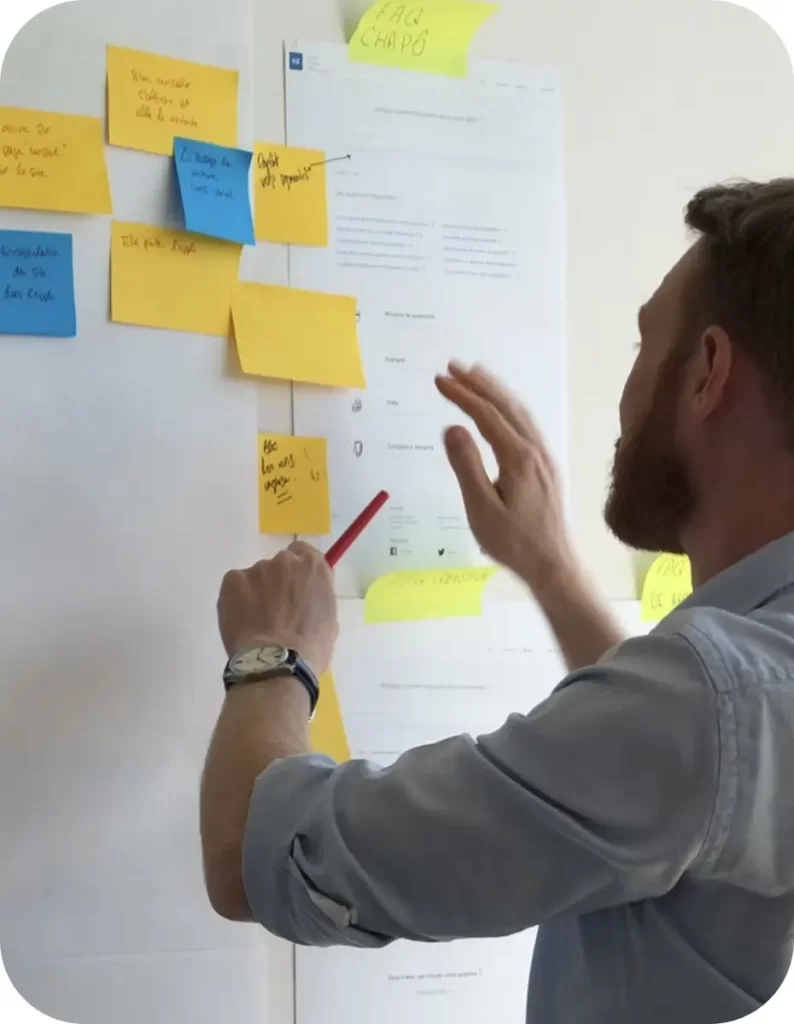Agile Methodology for Project Management

Agile methodology is one of the most popular and recognizable project management methodologies. This article will discuss what Agile Methodology is and what the benefits are in implementing projects with its iterative and incremental project execution concepts.
What is Agile Project Management?
Agile methodology is an iterative approach to project management and software development that prioritizes flexibility, collaboration, and customer feedback. Projects are broken down into smaller, manageable iterations called sprints, which typically last 2-4 weeks.
Agile is essentially a process to get the demands and solutions through a collaborative effort of self-organizing and cross-functional teams and their customers. The introduction of Agile Methodology was initially to cater to software development requirements.
The introduction of Agile methodology was to overcome the inadequacies associated with the traditional waterfall methodology, whose processes failed to meet the demands of the dynamic and highly competitive software industry.
Any project that requires flexibility and has a certain degree of uncertainty or complexity will benefit from it.
History of Agile Methodology
Agile was launched in 2001 by 17 technologists who put together the Agile Manifesto. They put together these four major principles to ensure agile project management and the development of software:
- Individuals and interactions OVER processes and tools
- Working software OVER comprehensive documentation
- Customer collaboration OVER contract negotiation
- Responding to change OVER following a set plan
“That is, while there is value in the items on the right, we value the items on the left more.”
Principles of Agile Methodology
The above-mentioned 17 technologists put together 12 principles of Agile Methodologies in the Agile Manifesto. These principles are as follows:
They also curated 12 Principles that are based on the Agile Manifesto:
- Our highest priority is to satisfy the customer through early and continuous delivery of valuable software.
- Welcome changing requirements, even late in development. Agile processes harness change for the customer’s competitive advantage.
- Deliver working software frequently, from a couple of weeks to a couple of months, with a preference for a shorter timescale.
- Business people and developers must work together daily throughout the project.
- Build projects around motivated individuals. Give them the environment and support they need, and trust them to do the job.
- The most efficient and effective method of conveying information to and within a development team is face-to-face conversation.
- Working software is the primary measure of progress.
- Agile processes promote sustainable development. The sponsors, developers, and users should be able to maintain a constant pace indefinitely.
- Continuous attention to technical excellence and good design enhances agility.
- Simplicity–the art of maximizing the work not done–is essential.
- The best architecture, requirements, and designs emerge from self-organizing teams.
- At regular intervals, the team reflects on how to become more effective, then tunes and adjusts its behavior accordingly.
Agile Vs. Waterfall Project Management
Unlike Agile Methodology, Waterfall is a linear and sequential approach to project management and software development. Projects progress through a series of distinct phases, from requirements gathering to design, implementation, testing, and maintenance, in a specific order.
The main differences between Agile Vs. Waterfall methodologies are as follows:
1. Flexibility:
- Agile: Agile is adaptive by design. Changes in requirements are expected and welcomed, even late in the development process.
- Waterfall: Changes in Waterfall are challenging to incorporate once the project has started. It’s less flexible because requirements are fixed at the beginning of the project.
2. Project Phases:
- Agile: Phases (like design, development, and testing) overlap and can happen concurrently. After each sprint, a potentially shippable product increment release (delivery) is possible.
- Waterfall: Phases are distinct and don’t overlap. Each phase must be completed before the next one begins.
3. Customer Involvement:
- Agile: Regular feedback from customers or stakeholders is a continuous process throughout the project. Customers are not on the other side of the table but are deeply involved in prioritizing features and reviewing progress.
- Waterfall: Customer feedback is typically at the beginning during requirements gathering) and at the end (during product delivery.
4. Project Size and Duration:
- Agile: Best suited for projects where the end product is undefined or subject to change. Ideal for projects that require regular feedback and adjustments.
- Waterfall: Suitable for projects with well-defined requirements and no anticipated changes in scope. Waterfall project management is now often chosen for short-term, smaller projects.
5. Risk Management:
- Agile: Continuous feedback and frequent iterations allow for early identification and resolution of issues. Therefore, the agile process enables addressing the high-risk items earlier.
- Waterfall: Identifying the risks is upfront; however, addressing them may take time until the testing phase. If issues arise late in the project, they can be costly and time-consuming.
6. Documentation:
- Agile: Focuses on working software over comprehensive documentation, especially the initial detailed requirement documents and functional & technical specifications in the beginning. However, creating the essential documentation is still the project’s needs.
- Waterfall: Emphasizes thorough documentation at every phase. The creation of detailed specifications takes place before the development phase begins.
Why Is Agile Project Management Helpful?
- This product methodology is flexible and responds well to changes, even during mid-execution.
- Even limited knowledge of the end product doesn’t affect project execution.
- Meeting the expectations of the client becomes easier due to quicker review cycles.
Limitations of Agile Methodology
- Understanding is absent in terms of the scope of flexibility or the project.
- It might not be an ideal cultural fit for certain companies.
- Pinpointing project deadlines and the resultant products becomes tricky due to its lack of predictability.
Roles of Team in Agile Framework
The overall aim of an Agile Software Development Process is to ensure meeting users’ requirements. For this, the team is responsible for documenting the needs and wants, a report on the scope of the problem, potential opportunities, etc.
The product owner will think about all these elements to capture the vision and share it with other team members to finalize and deliver it.
The main roles in the Agile Method are:
1. User
As mentioned above, the process involves ensuring meeting the user’s requirements. These requirements can change the life cycle of the project in an agile way. Understanding the requirements, we can define the type of project, the team, the research required, the cost, and more.
2. Product Owner
To meet users’ needs, the team needs a team member who will act as the voice of the customer. This will normally be the Product Owner, Internal Stakeholder, or the Project Manager.
This role will create, improve, and manage the vision board. It will look deep into the customer’s needs, the values that are being addressed, and what solutions and strategies are going to be implemented to address these values.
For example, Jeff Bezos’s original vision may have been, “I want to create an online store for people to purchase books and other products”.
The Product Owner works closely with the Software Development team to ensure meeting the project’s requirements. For the Software Development team to be successful in their role, it is dependent on the information they receive from the Product Owner to guarantee they understand the full scope of the project.
3. Software Development team
Software Development teams that use an Agile methodology differ from the traditional Software Development team. The team is considered multidisciplinary, where there is a combination of academic professionals who specialize in different approaches to a topic or problem. This way, we know that the job will get done.
The Software Development team can include Developers, Engineers, Analysts, Designers, Quality Assurance, and more. The members of the team are dependent on the project at hand.
The team members will have to collaborate to deliver working software that meets the user’s requirements. Regular stand-ups and pair programming meetings will ensure that an end-to-end functioning application is delivered effectively.
Steps To Follow for Agile Project Execution
An excellent idea is nothing without implementation. So, correctly implementing the agile framework is crucial to realize its benefits effectively.
The crucial steps for adopting the agile framework are as follows:
Step 1: Product Vision
It is important to identify the problem you are trying to solve using the agile framework and the impact it will have on the end-user or customers. Every product development and organization requires a vision.
The ownership of the task to develop this vision is with the “product owner.” The product version summarizes the primary benefits and features of the product the team is developing, along with a long-term vision of what the team has to achieve.
Step 2: Product Road Map
The product road map is to detail how a said product will grow. It offers a detailed summary of the development of the product and concentrates on objectives instead of just specific characteristics. The product manager must translate the vision confirmed by the strategy into a product roadmap.
Step 3: Agile Product Team
The three roles of the agile team are the product owner, scrum master, and team members. With the completion of the assignment of all the roles, the next step is to ensure the team works as a cohesive unit. A crucial part of the role assignment is the consideration of members’ professional qualifications and capabilities.
Step 4: Product Backlog
The next step is the creation of a product backlog. The product backlog is a list of all remaining tasks for product completion. The product backlog needs regular reviews to ensure the priorities are as per the project’s progress and needs.
Step 5: Sprint Backlog.
The sprint backlog refers to a list of work items needing completion by the team within a Sprint. These items are from a product backlog during the planning session. When the Sprint backlog is clear, it gives a detailed idea of what the team should and should not be doing during every Sprint.
Step 6: Release Planning
Release planning is to show the features and functionalities of the next release and inform the users of the process for it and other details.
Step 7: Planning The Sprint
At the beginning of every Sprint cycle, Sprint planning takes place. It shouldn’t take more than 2 hours at the start of every week or two weeks or as per the decided periodicity. After the plan is in place, it’s important to track the daily progress using a burndown chart. Again, communication is crucial while using agile methodology.
Step 8: Stand-Up Meetings and Sprint Reviews
Daily stand-up meetings of 10-15 minutes to improve team communication, collaboration, and transparency. Any highlights and problems the team faces during these meetings must be brought to notice.
As with a daily meeting, a Sprint review takes place after the completion of a sprint. This meeting ensures whether the initiative was followed and the highlights of the Sprint. It should also include any areas where there is scope for improvement.
Step 9: Sprint Retrospective
An essential aspect of the agile framework is to ensure a straightforward step is present after every step. This can be done during the sprint retrospective.
After completing a Sprint and displaying all its features, it is time to decide what to do. It’s not just about planning for the next Sprint but taking the time needed to discuss the previous one and any improvements that can be made for the next.
Using agile to improve productivity and efficiency is not a new-age concept. A variety of companies have been doing this for a while. Did you know Cisco, Lego digital solutions Barclays, Ericsson, PlayStation Network, Fitbit, and John Deere have utilized agile frameworks to improve productivity?
From creating cross-functional teams and restructuring the organizational framework to delivering higher-quality products and creating good-quality backlogs, agile has helped these organizations in numerous ways. These examples also show that the size of the company doesn’t matter. All that matters is whether there is a mindset for growth or not.
Conclusion: Agile is a Mindset
The Agile methodology is for flexibility and adaptability. Its principles, frameworks, and practices are perfectly curated to work well with today’s operating conditions.
The method does not apply specifically to a software developer, project manager, or CEO. It means that every member of the team and the decisions they make should be strategic about how they are in line and work collaboratively with other members’ decisions.
The aim is to be able to build as a team and swiftly make changes if required without impacting the user. At times of uncertainty, using the Agile mindset pushes you to think about other solutions, get feedback on these potential solutions, and adjust accordingly.
Keeping the four major values and 12 principles of the Agile Manifesto in mind, you can effectively choose the right practices, frameworks, techniques, and tools to use to collaborate with your team effectively and ensure customer satisfaction.
Many agile frameworks help with the development processes and align with the practices. The most popular agile framework is called Scrum.

Tavish lives in Hyderabad, India, and works as a result-oriented data scientist specializing in improving the major key performance business indicators.
He understands how data can be used for business excellence and is a focused learner who enjoys sharing knowledge.




